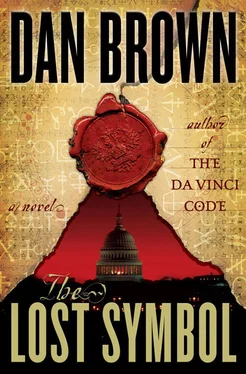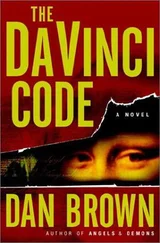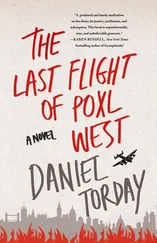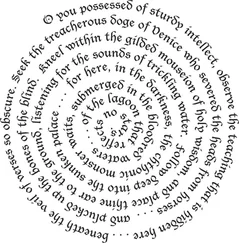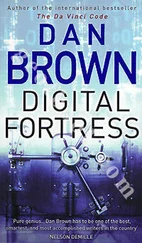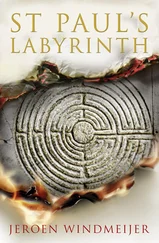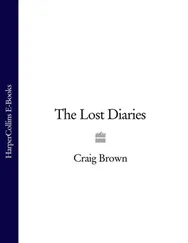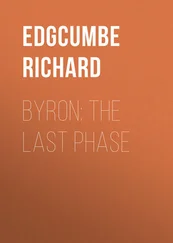This entire building, in fact, was a treasure trove of bizarre arcana that included a “killer bathtub” responsible for the pneumonic murder of Vice President Henry Wilson, a staircase with a permanent bloodstain over which an inordinate number of guests seemed to trip, and a sealed basement chamber in which workers in 1930 discovered General John Alexander Logan’s long-deceased stuffed horse.
No legends were as enduring, however, as the claims of thirteen different ghosts that haunted this building. The spirit of city designer Pierre L’Enfant frequently was reported wandering the halls, seeking payment of his bill, now two hundred years overdue. The ghost of a worker who fell from the Capitol Dome during construction was seen wandering the corridors with a tray of tools. And, of course, the most famous apparition of all, reported numerous times in the Capitol basement — an ephemeral black cat that prowled the substructure’s eerie maze of narrow passageways and cubicles.
Langdon stepped off the escalator and again checked his watch. Three minutes. He hurried down the wide corridor, following the signs toward the Statuary Hall and rehearsing his opening remarks in his head. Langdon had to admit that Peter’s assistant had been correct; this lecture topic would be a perfect match for an event hosted in Washington, D.C., by a prominent Mason.
It was no secret that D.C. had a rich Masonic history. The cornerstone of this very building had been laid in a full Masonic ritual by George Washington himself. This city had been conceived and designed by Master Masons — George Washington, Ben Franklin, and Pierre L’Enfant — powerful minds who adorned their new capital with Masonic symbolism, architecture, and art.
Of course, people see in those symbols all kinds of crazy ideas.
Many conspiracy theorists claimed the Masonic forefathers had concealed powerful secrets throughout Washington along with symbolic messages hidden in the city’s layout of streets. Langdon never paid any attention. Misinformation about the Masons was so commonplace that even educated Harvard students seemed to have surprisingly warped conceptions about the brotherhood.
Last year, a freshman had rushed wild-eyed into Langdon’s classroom with a printout from the Web. It was a street map of D.C. on which certain streets had been highlighted to form various shapes — satanic pentacles, a Masonic compass and square, the head of Baphomet — proof apparently that the Masons who designed Washington, D.C., were involved in some kind of dark, mystical conspiracy.
“Fun,” Langdon said, “but hardly convincing. If you draw enough intersecting lines on a map, you’re bound to find all kinds of shapes.”
“But this can’t be coincidence!” the kid exclaimed.
Langdon patiently showed the student that the same exact shapes could be formed on a street map of Detroit.
The kid seemed sorely disappointed.
“Don’t be disheartened,” Langdon said. “Washington does have some incredible secrets… just none on this street map.”
The young man perked up. “Secrets? Like what?”
“Every spring I teach a course called Occult Symbols. I talk a lot about D.C. You should take the course.”
“ Occult symbols!” The freshman looked excited again. “So there are devil symbols in D.C.!”
Langdon smiled. “Sorry, but the word occult, despite conjuring images of devil worship, actually means ‘hidden’ or ‘obscured.’ In times of religious oppression, knowledge that was counterdoctrinal had to be kept hidden or ‘occult,’ and because the church felt threatened by this, they redefined anything ‘occult’ as evil, and the prejudice survived.”
“Oh.” The kid slumped.
Nonetheless, that spring, Langdon spotted the freshman seated in the front row as five hundred students bustled into Harvard’s Sanders Theatre, a hollow old lecture hall with creaking wooden benches.
“Good morning, everybody,” Langdon shouted from the expansive stage. He turned on a slide projector, and an image materialized behind him. “As you’re getting settled, how many of you recognize the building in this picture?”
“U.S. Capitol!” dozens of voices called out in unison. “Washington, D.C.!”
“Yes. There are nine million pounds of ironwork in that dome. An unparalleled feat of architectural ingenuity for the 1850s.”
“Awesome!” somebody shouted.
Langdon rolled his eyes, wishing somebody would ban that word. “Okay, and how many of you have ever been to Washington?”
A scattering of hands went up.
“So few?” Langdon feigned surprise. “And how many of you have been to Rome, Paris, Madrid, or London?”
Almost all the hands in the room went up.
As usual. One of the rites of passage for American college kids was a summer with a Eurorail ticket before the harsh reality of real life set in. “It appears many more of you have visited Europe than have visited your own capital. Why do you think that is?”
“No drinking age in Europe!” someone in back shouted.
Langdon smiled. “As if the drinking age here stops any of you?”
Everyone laughed.
It was the first day of school, and the students were taking longer than usual to get settled, shifting and creaking in their wooden pews. Langdon loved teaching in this hall because he always knew how engaged the students were simply by listening to how much they fidgeted in their pews.
“Seriously,” Langdon said, “Washington, D.C., has some of the world’s finest architecture, art, and symbolism. Why would you go overseas before visiting your own capital?”
“Ancient stuff is cooler,” someone said.
“And by ancient stuff,” Langdon clarified, “I assume you mean castles, crypts, temples, that sort of thing?”
Their heads nodded in unison.
“Okay. Now, what if I told you that Washington, D.C., has every one of those things? Castles, crypts, pyramids, temples… it’s all there.”
The creaking diminished.
“My friends,” Langdon said, lowering his voice and moving to the front of the stage, “in the next hour, you will discover that our nation is overflowing with secrets and hidden history. And exactly as in Europe, all of the best secrets are hidden in plain view.”
The wooden pews fell dead silent.
Gotcha.
Langdon dimmed the lights and called up his second slide. “Who can tell me what George Washington is doing here?”
The slide was a famous mural depicting George Washington dressed in full Masonic regalia standing before an odd-looking contraption — a giant wooden tripod that supported a rope-and-pulley system from which was suspended a massive block of stone. A group of well-dressed onlookers stood around him.
“Lifting that big block of stone?” someone ventured.
Langdon said nothing, preferring that a student make the correction if possible.
“Actually,” another student offered, “I think Washington is lowering the rock. He’s wearing a Masonic costume. I’ve seen pictures of Masons laying cornerstones before. The ceremony always uses that tripod thing to lower the first stone.”
“Excellent,” Langdon said. “The mural portrays the Father of Our Country using a tripod and pulley to lay the cornerstone of our Capitol Building on September 18, 1793, between the hours of eleven fifteen and twelve thirty.” Langdon paused, scanning the class. “Can anyone tell me the significance of that date and time?”
Silence.
“What if I told you that precise moment was chosen by three famous Masons — George Washington, Benjamin Franklin, and Pierre L’Enfant, the primary architect for D.C.?”
More silence.
“Quite simply, the cornerstone was set at that date and time because, among other things, the auspicious Caput Draconis was in Virgo.”
Читать дальше
